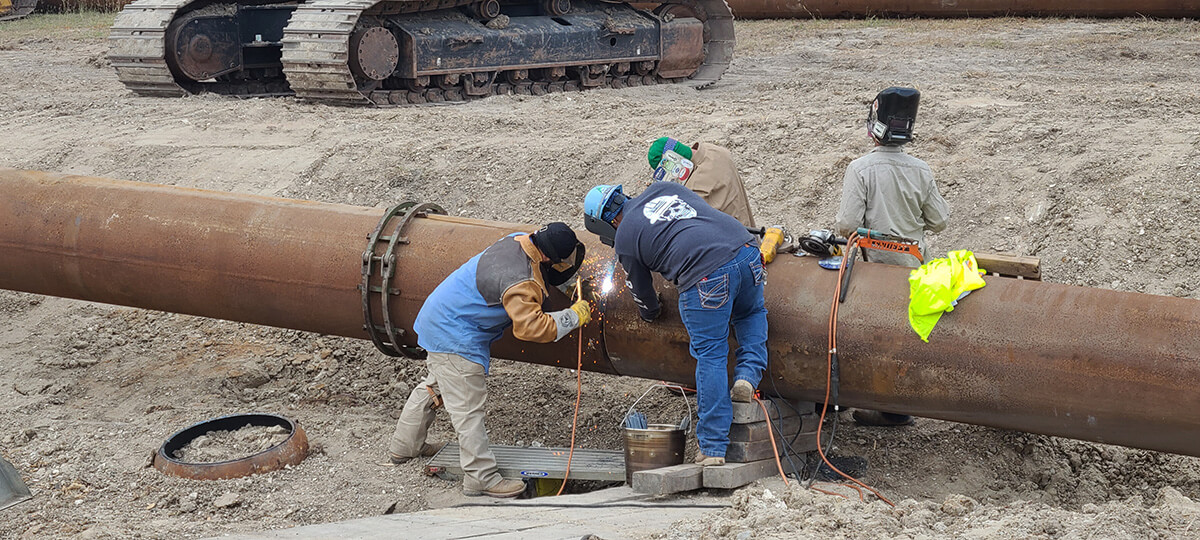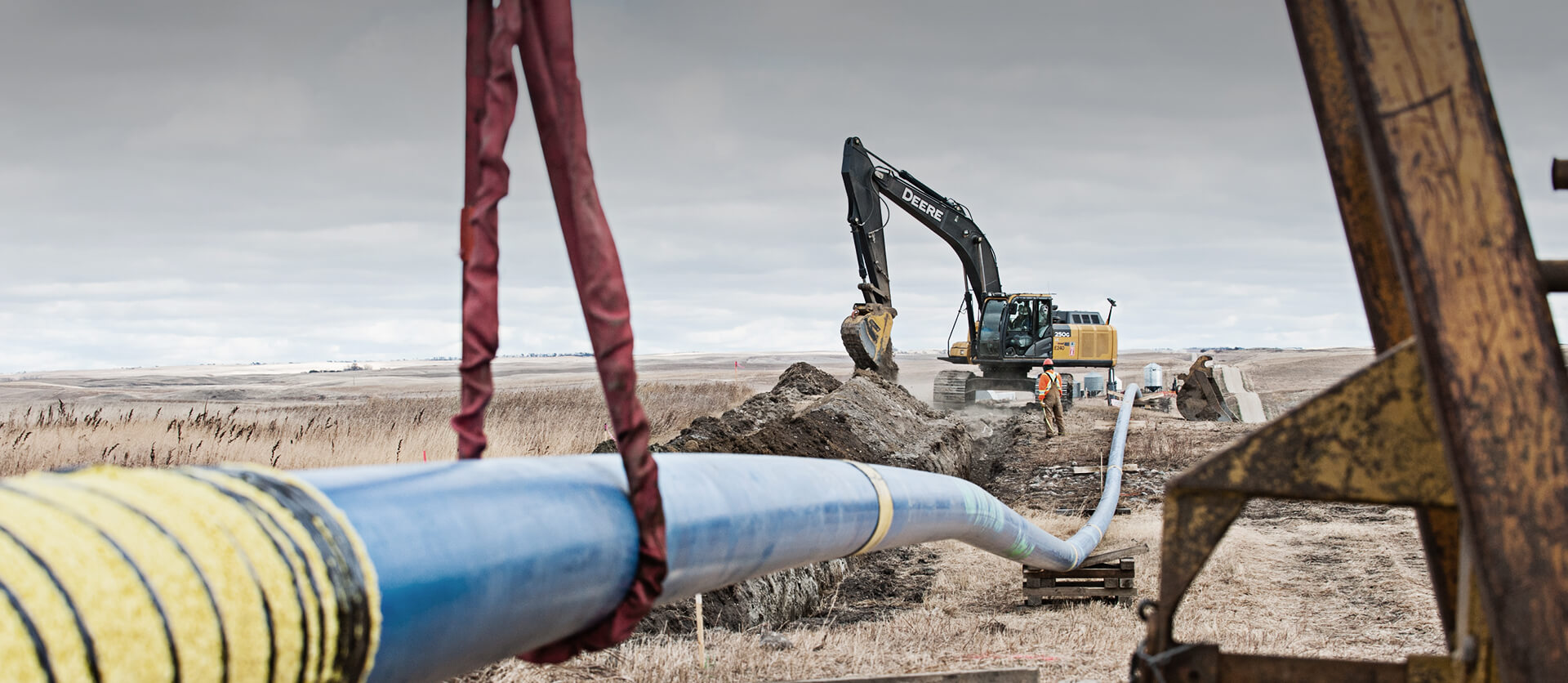Exploring the current Developments in Pipeline Construction Providers for Modern Projects
The Pipeline Construction market is undergoing considerable modifications. Innovations such as smart materials and robotics are improving traditional practices. These advancements guarantee to improve effectiveness and safety and security. In addition, AI technologies are boosting project monitoring capabilities. As these aspects merge, they elevate concerns regarding their lasting effect on sustainability and cost. Recognizing these advancements is essential for stakeholders wanting to browse this evolving landscape. What ramifications do they hold for future tasks?
The Increase of Smart Products in Pipeline Construction
As the demand for a lot more lasting and efficient Pipeline systems enhances, the combination of smart materials has actually arised as a transformative remedy in Pipeline Construction. These innovative products possess one-of-a-kind buildings that enhance the performance and long life of pipelines. For example, self-healing polymers can immediately fix small leaks, greatly decreasing upkeep prices and downtime. Furthermore, products embedded with sensing units can keep track of architectural stability and ecological conditions, permitting for real-time information collection and evaluation.
Wise products are frequently lightweight and corrosion-resistant, which not only simplifies setup but also expands the lifespan of the systems. Their versatility enables pipes to withstand extreme environmental conditions, advertising security and reliability. As industries increasingly prioritize sustainability, using environmentally friendly clever products adds to reduced environmental influence. Overall, the rise of smart materials marks a noteworthy shift in Pipeline Construction, leading the way for cutting-edge remedies to meet modern infrastructure demands.
Innovations in Robotics for Installment and Maintenance
The integration of smart products in Pipeline Construction is complemented by improvements in robotics, which are reinventing installment and upkeep processes. Robot innovations, such as automated welding systems and drones, boost efficiency and precision, reducing human mistake and decreasing safety dangers. These robots can operate in challenging settings, making certain that installations are conducted in remote or harmful areas without placing workers in danger.
Robotic inspection devices equipped with sophisticated sensing units give real-time information on Pipeline stability, permitting for aggressive maintenance. They can spot leaks or architectural weaknesses, enabling prompt treatments that prolong the life expectancy of Pipeline systems. Using robotics not only increases the Construction timeline however likewise optimizes resource appropriation, bring about cost savings. As these innovations remain to advance, they are readied to play a critical duty fit the future of Pipeline Construction, making sure dependability and sustainability in framework growth.
AI-Driven Project Administration Tools Transforming Process
AI-driven job management tools are reshaping workflows in Pipeline Construction by boosting decision-making processes through better accessibility to real-time information analytics. These tools allow teams to react promptly to job developments, consequently enhancing effectiveness. Structured communication networks foster partnership among stakeholders, better maximizing job end results.
Improved Decision-Making Processes

Real-Time Data Analytics
Harnessing real-time data analytics, modern project administration tools transform operations in Pipeline Construction. These advanced tools leverage expert system to provide instantaneous understandings right into project performance, source allotment, and potential threats. By continuously monitoring crucial performance indications, groups can swiftly adjust to altering problems, maximizing labor and products use. The combination of real-time data enables more informed decision-making, minimizing delays and decreasing prices. Additionally, predictive analytics can recognize patterns and forecast obstacles prior to they rise, improving overall job efficiency. Consequently, Pipeline Construction companies that adopt these AI-driven tools can enhance task timelines and outcomes, guaranteeing they stay affordable in an increasingly intricate market landscape. This development notes a considerable change toward data-centric administration methods.
Streamlined Interaction Channels
Reliable interaction is paramount in Pipeline Construction, where various stakeholders must collaborate perfectly to assure project success. The intro of AI-driven task management devices has transformed communication channels within the industry. These devices facilitate real-time details sharing, permitting teams to accessibility updates, share files, and track progression effectively. By automating regular jobs and providing a centralized platform for interaction, these developments get rid of misconceptions and lower delays. Improved presence into job timelines and source allocation cultivates responsibility amongst group members. Furthermore, AI analytics can recognize potential communication voids, making certain aggressive analytical. Ultimately, structured interaction networks not just enhance operations but also elevate overall project efficiency, enabling Pipeline Construction firms to satisfy modern needs efficiently.
Improved Safety Methods With Modern Technology Integration
The assimilation of modern technology in Pipeline Construction has actually resulted in boosted safety methods. Real-time tracking systems, wearable safety tools, and automated danger evaluations are now crucial elements in lessening threats on task websites. These developments not just enhance worker safety but likewise enhance compliance with sector policies.
Real-Time Tracking Solutions
Just how can real-time surveillance systems change Pipeline Construction safety and security procedures? By incorporating advanced technology, these systems supply continual surveillance of Construction tasks, ensuring immediate detection of prospective risks. Sensing units and video cameras can check ecological problems, devices efficiency, and workforce movements, delivering essential data in real time. This positive method enables job supervisors to recognize threats prior to they intensify, significantly enhancing precaution on-site. Additionally, real-time tracking helps with conformity with regulative requirements, ensuring that security requirements are met consistently. The ability to assess data immediately supports informed decision-making, enabling timely treatments. As an outcome, Pipeline Construction jobs can run much more efficiently while safeguarding the wellness of employees and minimizing crashes, thus revolutionizing the sector's safety landscape.
Wearable Safety Gadgets
Often, wearable security tools are being incorporated right into Pipeline Construction to improve security methods. These innovative tools, including wise helmets, vests, and wristbands, are designed to keep track of worker health and wellness and ecological conditions in real-time. Equipped with sensors, these gadgets can discover risks such as harmful gas direct exposure, excessive warmth, or high noise levels, offering prompt alerts to managers and workers. Furthermore, wearable innovation commonly consists of Discover More Here GPS tracking features, enabling efficient location monitoring of employees on-site. This ability not only help in fast reaction during emergencies but additionally boosts overall job management. By prioritizing worker safety and security through modern technology integration, Pipeline Construction companies are making considerable strides in decreasing accidents and advertising a culture of safety and security within the market.

Automated Danger Assessments
While traditional risk evaluations frequently depend on hands-on assessments, the combination of computerized threat evaluation modern technologies is changing safety procedures in Pipeline Construction. These advanced systems leverage information analytics, expert system, and artificial intelligence to identify possible hazards more properly and successfully. By continuously checking environmental problems, tools standing, and worker actions, automated evaluations provide real-time understandings that enhance decision-making. This positive strategy decreases the likelihood of crashes and boosts compliance with safety laws. In addition, automated danger assessments can be updated instantaneously, making certain that all stakeholders have accessibility to the current details. As a result, Pipeline Construction jobs take advantage of a safer workplace, decreasing disruptions and promoting a culture of safety through innovation integration.
Sustainable Practices in Pipeline Construction
As the need for power infrastructure rises, the Pipeline Construction industry increasingly focuses on lasting practices that decrease ecological influence. Firms are embracing environment-friendly materials and innovative Construction strategies to reduce their carbon impact. For instance, making use of trenchless technology permits Pipeline installation with very little disturbance to the surrounding setting, protecting natural environments and minimizing dirt erosion.
In addition, the implementation of sustainable power resources, such as solar or wind, to power Construction activities is acquiring grip. This shift not just reduces reliance on nonrenewable fuel sources but additionally enhances the general sustainability of Pipeline jobs. Reliable waste monitoring methods, consisting of recycling and reusing materials, are coming to be standard in the sector.
Real-Time Monitoring and Anticipating Upkeep Solutions
The change towards sustainable techniques in Pipeline Construction has actually led the see here now way for the assimilation of real-time monitoring and anticipating upkeep services. These technologies utilize advanced sensors and data analytics to constantly assess Pipeline stability and functional efficiency. By collecting data in actual time, operators can find abnormalities such as leaks or stress declines prior to they intensify into significant concerns. This positive approach not just reduces ecological risks but likewise lowers downtime and upkeep expenses.
Predictive maintenance utilizes algorithms to anticipate possible failures based upon historical data and current efficiency metrics. This allows prompt interventions, optimizing upkeep timetables and source allowance. Overall, real-time surveillance and anticipating upkeep options represent a considerable development in Pipeline Construction, enhancing safety and integrity while sustaining sustainability objectives. As markets continue to welcome these technologies, the operational landscape of Pipeline monitoring is established to advance substantially, making sure long-lasting practicality and efficiency.
The Role of Drones in Evaluating and Evaluation
Drones have actually become transformative devices in the evaluating and assessment of pipes, using boosted effectiveness and precision. Their capacity to capture high-resolution pictures and video clips from various angles permits detailed analyses of Pipeline honesty without risking human safety and security. Outfitted with sophisticated sensing units and thermal imaging capacities, drones can detect leakages, deterioration, and architectural abnormalities that may not view it show up to the nude eye.
The release of drones considerably decreases evaluation time, enabling quicker decision-making for upkeep and repair services. This performance equates to cost financial savings and minimal interruption to surrounding settings. Drones can also access hard-to-reach areas, such as elevated structures or tough terrains, additionally broadening the scope of evaluations.
As the Pipeline market remains to embrace technological innovations, the integration of drones right into evaluating and examination procedures is anticipated to expand, setting brand-new standards for functional quality and security in Pipeline Construction solutions.
Frequently Asked Concerns
What Are the Expenses Connected With Modern Pipeline Construction Innovations?
The prices connected with modern-day Pipeline Construction advancements commonly consist of sophisticated materials, specialized labor, and cutting-edge innovation. These variables contribute to higher initial financial investment, but can lead to long-lasting financial savings with improved efficiency and minimized maintenance needs.
Exactly How Do Governing Adjustments Impact Pipeline Construction Technologies?
Governing changes substantially influence Pipeline Construction technologies by necessitating the fostering of much safer, extra reliable approaches. Compliance demands usually drive development, leading to innovations in products, layout, and Construction techniques that enhance total project sustainability and security.
What Skills Are Required for Jobs in Advanced Pipeline Construction?

Occupations in advanced Pipeline Construction require knowledge in engineering concepts, task management, security methods, and ecological policies. Additionally, abilities in modern technology integration, synergy, and analytical are essential for passing through the complexities of modern framework tasks.
Just How Can Business Ensure Compliance With Environmental Specifications?
To ensure compliance with environmental requirements, firms ought to apply extensive training programs, conduct routine audits, and take on finest techniques in sustainability. Engaging with stakeholders and keeping an eye on governing changes further reinforces their commitment to ecological stewardship.

What Are the Trick Obstacles Encountering Pipeline Construction Today?
The crucial obstacles facing Pipeline Construction today consist of regulative conformity, ecological concerns, changing material prices, labor lacks, and the requirement for advanced modern technology assimilation (Pipeline Construction Services). These elements complicate job timelines and total efficiency in the industry
As the demand for a lot more sustainable and efficient Pipeline systems raises, the assimilation of clever materials has actually arised as a transformative solution in Pipeline Construction. AI-driven project management devices are reshaping process in Pipeline Construction by enhancing decision-making procedures through improved accessibility to real-time data analytics. While job monitoring in Pipeline Construction has typically depended on manual processes, the combination of advanced tools considerably enhances decision-making capabilities. Utilizing real-time data analytics, contemporary project administration tools change operations in Pipeline Construction. Professions in advanced Pipeline Construction need know-how in engineering concepts, project management, security procedures, and environmental laws.